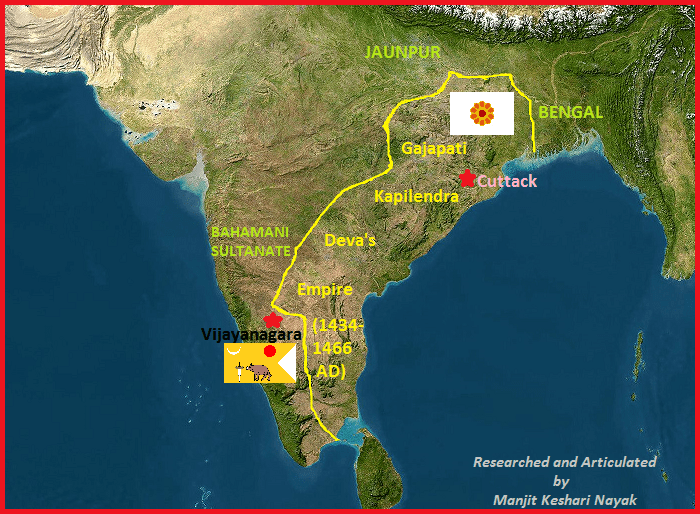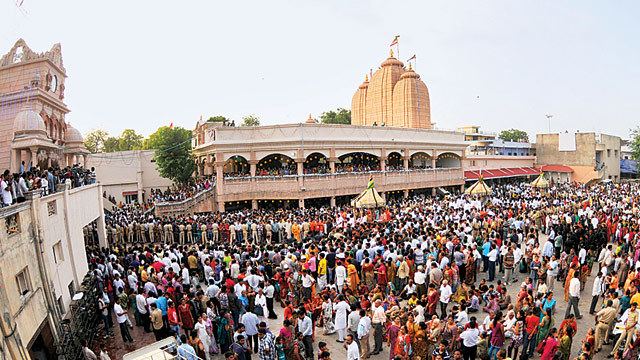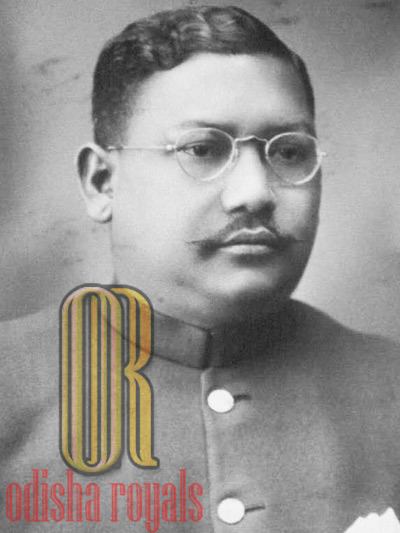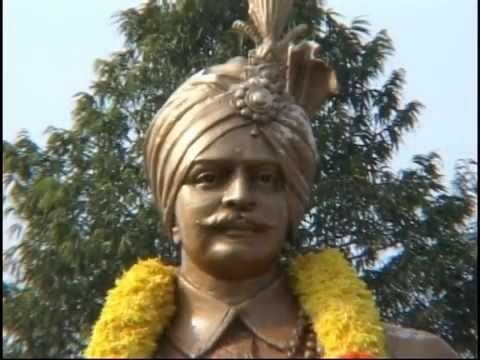Name Kapilendra Routaray | ||
 | ||
Kapilendra Deva Routaray (Odia : କପିଳେନ୍ଦ୍ର ଦେବ ରାଉତରାୟ) was an Odia emperor from 1434-1466 AD of a large part of the Indian subcontinent and the founder of the Gajapati dynasty. His name is also written as Kapilendra Routray or Sri Sri Kapilendra Deva. In claiming descent from the Surya Vamsha (Sun dynasty) of the Mahabharata, he also took the title shri shri ...(108 times) Gajapati Gaudesvara Naba Koti Karnata Kalbargesvara. This title literally meant the lord of Bengal (Gauda), of Karnataka region or Vijayanagara kingdom, of Golkonda kingdom and of nine crore subjects. The title is still used by the sun dynasty kings of Puri on ritual occasions.
Contents
- The Initial Life of Kapilendra Deva
- Establishing his Rule and Suppressing Internal Rebellions
- Military Conquests and Territorial Expansion
- Conquest of Rajamahendri
- Subjugation of Vijayanagar Kingdom and Expansion till Tiruchirappalli
- Conquest of Telegana Gulberga or Kalaberga
- Campaigns against Bahmani Sultanate and March on Bidar
- Construction Activities and Cultural Renaissance of the Odia Society
- Last days of Kapilendra Deva
- References

The Initial Life of Kapilendra Deva

There are separate theories or concepts about Kapilendra Deva's initial life. In Madala Panji records of Puri temple it states that he was known as Kapila Routa and was born in a poor family whose job was to take care of domesticated cows. Due to a divine symbol of cobra (naga) seated by his head while he was resting, he was predicted to become a king one day. Another note from the same records state that he used to be a robber by profession and appointed his friend from his gang called Kali Dasa as the head priest of his court once he became a king. In the third statement from the same records it states that he used to beg in front of the Puri Jagannath temple as a child and was later adopted by the last Eastern Ganga dynasty ruler Bhanudeva following a divine dream. He was later appointed in his young days as a military general of the Ganga forces and was assigned the task to fight the Muslim forces of Bengal.
Establishing his Rule and Suppressing Internal Rebellions

Due to the weakening administration of the Eastern Ganga dynasty rulers, Kapilendra Deva mounted the throne with internal support while the last ruler of the dynasty, Bhanu Deva was on a military expedition in the southern territories. He was declared as the new king with a rajyabhishek ceremony at Bhubaneswar. Since the accession was based on a coup or rebellion, some feudal kings of Odisha like Matsarvamshi of Oddadi, Shilavamshis of Nandapur, Bishnukundina of Panchadhara, etc. declined his authority and declared themselves independent. Around the same time, the Sultanate of Jaunpur also posed as an external threat to his kingdom. He appointed his able minister Gopinath Mahapatra to deal with the Jaunpur threat which was successfully executed by him and Kapilendra Deva himself suppressed the internal rebels with force. The rebels were suppressed by the year 1440 A.D. The rebellious troubles dealt by him with force are proven by his Lingaraj Temple declaration in which he has ordered the rebels to accept his rule or be toppled from power.
Military Conquests and Territorial Expansion

The military hegemony of Odisha had declined during the last line of Eastern Ganga dynasty rulers which provided enough opportunity for the rising powers in its neighborhood. When Kapilendra Deva took over the throne, hostile Muslim powers like the Sultan of Jaunpur (Mahmud Shah), Bahmani Sultanate and the young ruler of Bengal Samsuddin Ahmad Shah were continuously preparing to invade Odisha. Deva Raya II of Vijayanagara along with Reddys of Rajmahendri had advanced as far as the Simhanchalam territory in the south. Along with suppressing internal rebellions, Kapilendra Deva first defeated the Jaunpur forces with the help of his minister Gopinath Mahapatra and contained Bengal forces with the help of his minister Joginath Mahapatra after which only he initiated his aggressive military campaigns.
Conquest of Rajamahendri

Subjugation of Vijayanagar Kingdom and Expansion till Tiruchirappalli

From the documents of Gangadasa Bilasa Charitam it is known that Kapilendra Deva ordered Hamvira Deva to conquer Vijayanagar and Bahmani sultanate. Hamvira Deva successfully captured the Vijaynagar capital, Hampi and forced the weak ruler Malikarjuna Raya to pay yearly taxes. Hamvira Deva's commander Tamavupala conquered the southern states of Udayagiri (Nellore district) and Chandragiri in the year 1460 A.D.. The rock edicts of Srirangam temple near Trichinapalli dictate that Hamvira Deva captured as far as Trichinapalli, Tanjore and Arcot in south before stopping his advance. Hamvira Deva assumed the title of Dakshina Kapileswara in the year 1464.
Conquest of Telegana (Gulberga or Kalaberga)
The political situation of Telegana provided an opportunity for the Gajapati army to intervene and capture the territory. The Velama chiefs of Devara Konda in Telegana and the Bahmani sultan Aladdin Ahmad Shah II had cordial relations in the initial stages but on the event of war between Vijayanagar and Bahmani Sultanate, the Velama chiefs provided assistance to Vijayanagar. In an act of revenge the Bahmani sultan invaded the Telegana region and the Bahmani commander Sanjar Khan exerted barbaric atrocities on the common people. Hindus were sold as slaves. In 1456 A.D. Humayun Shah ascended the throne of the Bahmani sultanate and his general Sikander Khan suppressed the rebel Velama chiefs after occupying Devara Konda. Kapilendra Deva was invited by the Velama chiefs to rescue the Telegana population from the Bahmani rulers. In 1458 A.D. a battle ensued at Devara Konda between Odia forces led by Hamvira Deva and Bahmani forces. As a result of this battle Odia forces came out as victorious and Telegana region became a feudal state of the Gajapati empire with the Velama chiefs as the vassal rulers.
Campaigns against Bahmani Sultanate and March on Bidar
Construction Activities and Cultural Renaissance of the Odia Society
Kapilendra Deva patronized vaishnavism and expanded the Jagannath temple at Puri. Although his entire life was spent in warfare, the Jagannath temple became the center for an efflorescence of drama and dance (Odissi) and other forms of art during Gajapati rule. He was a great patron of Vedic culture and himself wrote a Sanskrit play called Parshuram Bijaya. He constructed the Shaivite temple of Kapileswar in Bhubaneswar which shows that he was tolerant to every sectarian belief under the Hindu domain. It was during the rule of Kapilendra Deva when Odia language was officially used as an administrative language and the poet Sarala Das wrote the Odia Mahabharata. Sarala Das was of a lower Shudra caste and was still patronized by Kapilendra Deva over the dominant social system of Brahmins. However, he was also a promoter of Brahminical councils which was due to his respect for the Vedic spiritual knowledge obtained by them. Several learned poets and writers were promoted by him.
Kapilendra Deva had declared himself as the servant ruler of lord Jagannath which also reflects from his title Routaray meaning the lord's servant king. Narendra tank at the Puri Jagannath temple premises was constructed by Kapilendra Deva in the memory of his martyred younger brother, Veer Narendra Deva. Fourteen out of sixteen ghats of the tank are named after his fourteen nephews. The two concentric defensive stone walls known as Kurma Prachira (the inner wall measuring 400’ x 278’) and Meghanada Prachira (the outer wall measuring 665’ x 644’ with height varying from 20’ to 24’) were constructed during the rule of Kapilendra Deva. The Chandan Jatra festival of Lord Jagannath was initiated during his rule. He himself donated a large amount of jewelry and utensils to the Puri temple during the 41 anka of his rule. Kapilendra Deva was a builder of a welfare state and had ordered not to commit atrocities or impose excessive hardships on the people of his kingdom.
Last days of Kapilendra Deva
Kapilendra deva was troubled by treacherous internal subjects who were opposed to his overthrowing of the Eastern Ganga dynasty. His edicts in the Puri Jagannath temple towards his end days provide a glimpse of his troubled state of mind due to rebels and traitors. He had taken oath to punish all those who rebelled against him. Before his death in 1466 A.D., he chose his youngest son Purushottama Deva, as heir, resulting in a rebellion by Hamvira Deva. In 1472, Purushottam was defeated and Hamvira Deva became king, but in 1476 A.D., Purushottam fought back and recaptured the throne.
